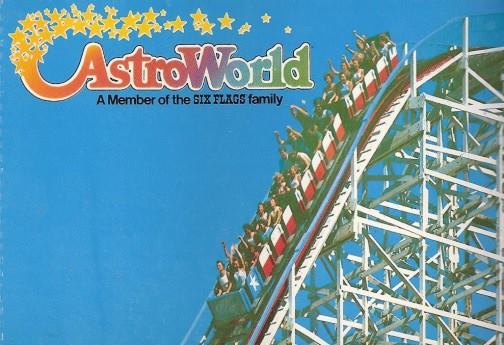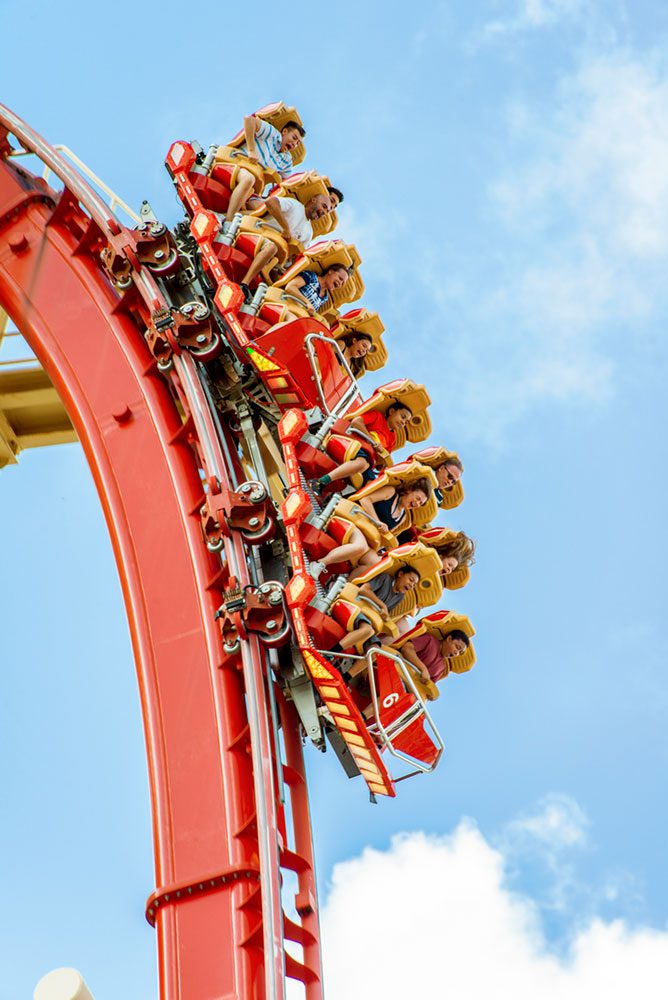Never felt like FJ was a rough ride. Rip, Ride, Rock it certainly is. Crappy design because it was shoehorned in.
Being shoehorned into the site isn't the issue with Rockit. Being a huge Maurer Sohne X-car design is.
<nerd hat on>
The design of the train is fundamentally flawed. They are basically 3 bench/row cars on a chassis that has the wheel assemblies of a 2 bench/row car that is then is tied together with a lengthy coupler. The geometry of the chassis path through the circuit is vastly different from the geometry of what the wheel's travel. The difference between the two makes the chassis serve as a fulcrum which means the two ends of each car (front row and back row) are like a teeter totter/see saw and get subjected to forces that are uncontrolled by the ride path. If anyone has ridden in the very back of a school bus and noted how "bouncy" it is, this effect on a roller coaster train where the rear seats "hang" off the wheels is very similar as the seat's pivot point is forward of the ridding position. Every change in direction Rockit's cars go through, subject the front row and back row to these unusual forces. This takes a toll on the riders as well as the wheels, chassis, and couplers on the trains.
If you look at the picture below, notice the angle of the chassis compared to track. Note how the lines of the chassis are very different from each other and also how the seats above them are very different in relation to row's 1, 2, and 3, and the track beneath them. The train is basically trying to follow the ride path of row 2 (the middle of the two wheels) and row 1 and 2 are extensions of that.
The long chassis/short wheelbase trains also mean that the chassis floor has to sit up higher off the wheels and thus creates a higher center of gravity. This also contributes to more "unusual" forces Rockit experiences compared to other designs. The higher chassis is because the long coupler has to clear the front and back rows as the train moves through the course.
All of these design choices are why it rides the way it does. It also is why the ride has some maintenance headaches as it by far is the biggest full circuit X-Car around.
Of course, UO didn't have to head down this path. Maurer won the bid because they would do the vertical lift UO wanted and they were cheaper than the option Universal Japan went with for a very similar site constrained design in Hollywood Dream. B&M didn't want to work with the vertical lift mandate and would've been much more than what was selected.
Just goes to show you get what you pay for.
BTW - the wheel/seat geometry in coasters does make from some interesting ride experiences. For example:
- Son of Beast (now defunct) at Kings Island originally had the same 3 bench cars with wheels designed for 2 rows and the forces those trains put on the structure were a part of the demise of that ride (along with RCCA and that it was a 200ft wooden coaster).
- Any old NAD wooden coaster train in row 3 has a bit of extra airtime kick because of a similar wheel to seat location. Best example of this currently is Kennywood's Thunderbolt in row 3 as it engages the lift. Nice little pop of airtime that is much more pronounced in row 3 than it is in row 2 or 1.
- Magnum XL-200 is a good ride that can demonstrate the differences between rows on a car. While it has a more traditional wheel to seat configuration with the wheels being under the feet of the riders in row 1 of a car and under the seat of row 3, it does have the very, very angular "triangular" shaped airtime hills at the end of the ride. This makes car 1, row 3 referred to as the "Magic Seat" by enthusiasts as when the ride crests over the pointy hills, row 3 pivots very quickly over the crest launching riders into the lap bar. I always preferred the back car's front row to the Magic Seat as instead of simply launching you hard into the lap bar as you crest the hill, the pivoting action of the train propels you slightly forward and then up. This makes the ending run of hills behave a bit more like traditional hills instead of Ron Toomer's coat hanger designed method of bending track.
- The best example of what wheelbase can do to a ride experience these days is the Coney Island Cyclone. It has 4 row cars in its trains. That is what makes the hills and turns on it very "snappy" and forceful. When that ride was in jeopardy of closing forever in the 70's the now defunct AstroWorld cloned it and made the Texas Cyclone. Only that instead of parabolic curves, the designer Bill Cobb used a lot of straight angles connected with sharp radiuses. When it first opened, it also used 4 bench trains like the original. For those enthusiasts lucky enough to ride it during the first few years, it was the ultimate in "poppy" forces. Just take a look at that back car in the photo below getting ready to "snap" into line with the other cars on the first drop. By the time I got to ride this classic, it had already been neutered with different trains and a reprofiled layout. Oh what I would've done to take a trip on this pre-modifications. Also note how similar the chassis angles are compared to Rockit's photo above.



